Third Term Social Studies Lesson Note for JSS2
ACCESS ALL LESSON NOTES
ACCESS ALL QUESTIONS AND ANSWERS
ACCESS ALL WORKSHEETS
ACCESS ALL JOBS ACCESS
ACCESS WAEC QUESTIONS AND ANSWERS
ANGLES IN A POLYGON
CONTENT
- Definition of Polygons
- Types Of Polygons
- Sum of Interior Angles in a Polygon
- Sum of Exterior Angles in a Polygon
Definition of Polygons
A closed plane figure bounded by straight lines (edges) is called a polygon. The number of sides of a polygon determines its names. The table below describes the names of polygons according to the number of their sides:
|
No. of sides and angles |
Polygon |
|
|
3 |
Triangle |
|
|
4 |
Quadrilateral |
|
|
5 |
Pentagon |
|
|
6 |
Hexagon |
|
|
7 |
Heptagon |
|
|
8 |
Octagon |
|
|
9 |
Nonagon |
|
|
10 |
Decagon |
|
|
11 |
Undecagon/Hendecagon |
|
|
12 |
Dodecagon |
|
|
15 |
Pentadecagon |
|
|
20 |
Icosagon |
|
Types Of Polygons
1. Convex Polygon:
A convex polygon has all its interior angles pointing outwards. No angle is pointing inwards. Each internal angle of a convex polygon is always less than 1800. A polygon is convex if any line segment joining any two points on it stays inside the polygon itself. Examples of convex polygons are shown below:
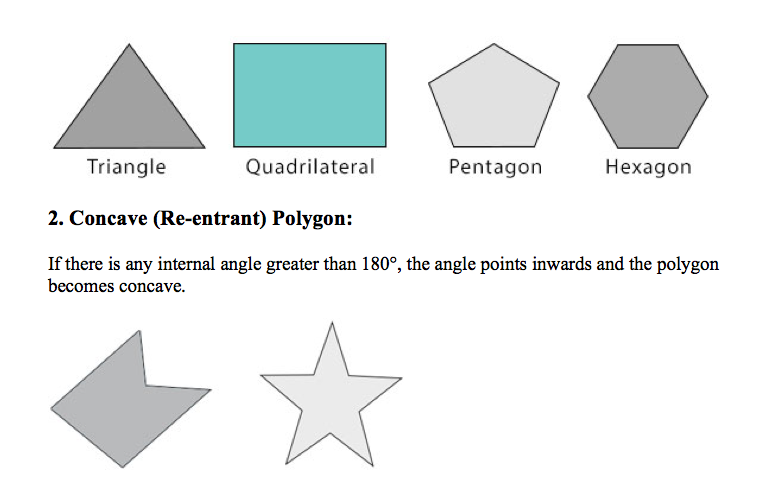
3. Regular Polygon:
This is a polygon with all its angles the same size and all its sides the same length.
4. Irregular Polygon:
This is a polygon with at least two of its sides of different length and at least two of its angles unequal.
CLASS ACTIVITY
For each of the polygons drawn below, state (i) whether it is concave or convex (ii) whether it is regular or irregular (iii) its name according to the number of sides.

Sum of Interior Angles in a Polygon
The sum of interior angles in a polygon is derived from the number of triangle that can be drawn from the polygon. Consider the diagrams below:

From the above diagrams;
4 sided Quadrilateral has 2 triangles, 5 sided Pentagon has 3 triangles and 6 sided hexagon has 4 triangles. We can therefore say that a n-sided polygon has n – 2 triangles.
Since sum of angles in a triangle is 180o;
A polygon with 4 sides having 2 triangles will have 2 × 180o= 360o
A 5-sided polygon having 3 triangles will have 3 × 180o = 540o
A 6-sided polygon having 4 triangles will have 4 × 180o = 720o
In general, the sum of the interior angles of any convex n-gon (polygon with n sides) is given by:
Sum of interior angles = (n − 2) × 1800 = (n − 2) × 2 × 90
Or Sum of interior angles = (2n − 4) × 900
Or Sum of interior angles = (2n – 4) Right angles
For a regular polygon that has all its sides and angles equal, the size of each interior angle will be the average of the sum of all interior angles
Therefore each interior angle for a regular convex polygon
Each interior angle = sum of interior anglesnumber of sides
= n−2×180on
Example 1:
What is the sum of the interior angles of a pentagon?
Solution:
A pentagon has five sides, that is, n = 5.
Therefore, sum of interior angles = (n − 2) × 1800
= (5 − 2) × 1800
= 3 × 1800 = 5400
Example 2:
Calculate the size of each interior angle of a regular heptagon.
Solution:
A regular heptagon has 7 equal sides, that is, n = 7.
Each interior angle = sum of interior anglesnumber of sides
= n−2×180on
= 7−2×180o7 = 5×180o7
= 900o7
= 12857o
CLASS ACTIVITY
- What is the sum of interior angles of a: (a) hexagon (b) nonagon
- The sum of six of the interior angles of a nonagon is 9200. The other three angles are all equal. Find the size of each of the other three angles.
- If the angles of a quadrilateral are x, 2x and 3x, what is the value of x? Calculate the size of the largest angle.
Sum of Exterior Angles in a Polygon
Sum of exterior angles in any polygon = 3600
Example 1:
The sum of the interior angles of a regular polygon is 10 right angles.
(i) How many sides has the polygon?
(ii) What is the sum of the exterior angles of the polygon?
(iii) Calculate the size of each exterior angle of the polygon.
Solution:
Sum of interior angles = (n − 2) × 1800
= (n − 2) × 2 × 900
Sum of interior angles = (2n − 4) × 900
Sum of interior angles = (2n − 4) right angles
2n – 4 = 10
2n = 10 + 4
2n = 14
Therefore, n = 7 sides
(i) Sum of exterior angles = 3600
(ii) Each exterior angle = sum of exterior anglesnumber of sides
= 360o7
= 5137o
CLASS ACTIVITY
- Calculate the size of each exterior angle in a regular: (a) octagon (b) decagon
- Is the sum of exterior angles of a triangle equal to the sum of exterior angles of an Icosagon?
ANGLES OF ELEVATION AND DEPRESSION
CONTENT
- Horizontal and Vertical Planes
- Angles of Elevation and Depression
- Measuring Angles of Elevation and Depression
- The Relationship between Angle of Elevation and Depression
- Scale Drawing
Horizontal and Vertical Planes
An horizontal plane lies (flat) in the same position as the ground while a vertical plane stands like a straight wall.
Angles of Elevation and Depression
Angle of Elevation
The angle that an observer would raise his or her line of sight above a horizontal line in order to see an object. The angle of elevation is the angle between the horizontal and the observer’s line of sight.
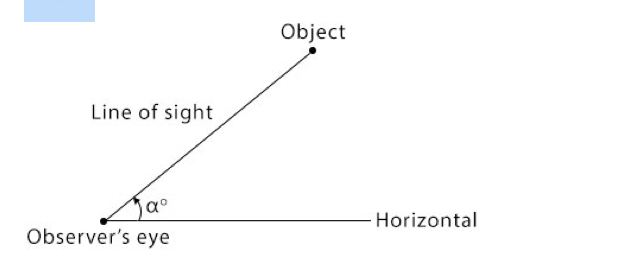
In the diagram above, the angle of elevation of the object from the observer is α0.
Angle of Depression
If the object is below the level of the observer, then the angle between the horizontal and the observer’s line of sight is called the angle of depression. If an observer wereup above and needed to look down, the angle of depression would be the angle that the person would need to lower his or her line of sight.

Measuring Angles of Elevation and Depression
Angles of elevation and depression can be measured with a simple instrument called Clinometers. Simple Clinometers is made from a chalk-board protractor in which a plumb-line hangs from the center of the protractor. The angle that the plumb-line makes with the 900 vertical axes when the Clinometers is placed in the observer’s direction is the angle of elevation or depression.

In the figure above, a plumb-line hangs from the center of the protractor at A. The observer sights an object along the line BAC. The angle of elevation e0 is the angle between AO and the plumb-line. The size of e0 can be read from the scale. Notice that e0 increases from 00 at O to 900 at B.
NOTE: The teacher should make simple clinometers using a chalk-board protractor and plumb-line.
CLASS ACTIVITY
Carry out the following activities using a tape and clinometers:
- Stand at a point Y on level ground, where the top of the wall in your class has an angle of elevation of 450
- Find the distance from Y to the base of the wall in your class. Record the height of the wall.
The Relationship between Angle of Elevation and Depression
In other words, as shown in the diagrams below, the angle formed with the horizontal when an observer looks up is called angle of elevation whereas, the angle formed with the horizontal when an observer looks down is called angle of depression.


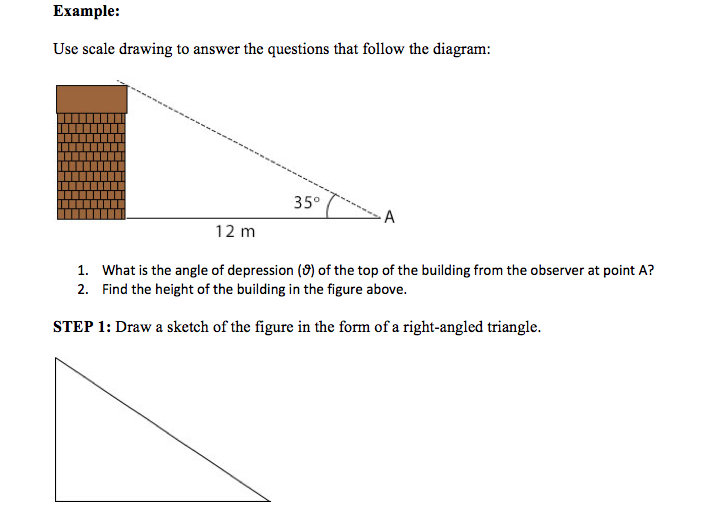
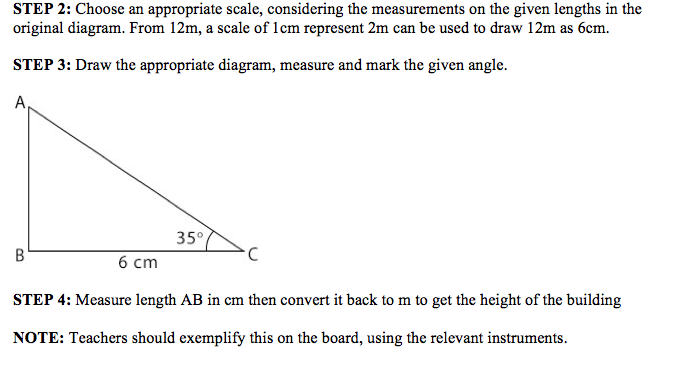
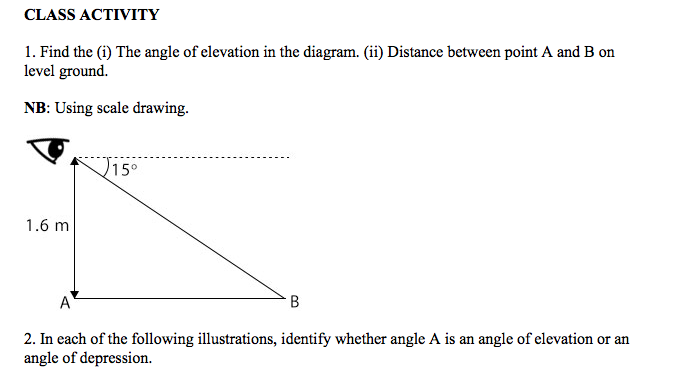
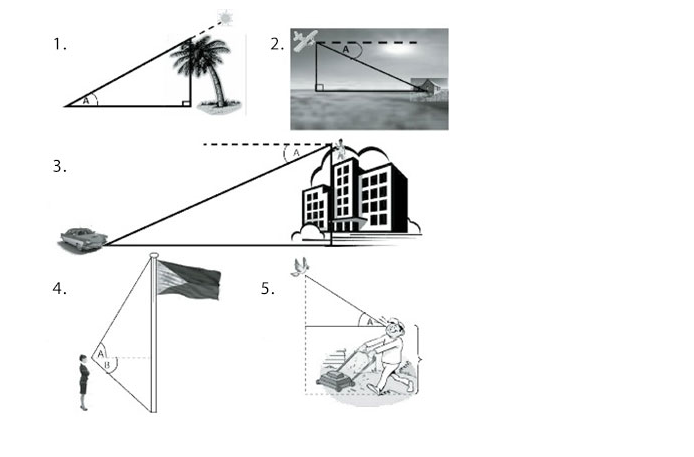
3. When the elevation of the sun is 33o, a student has a shadow of 2.9m long. Make a scale drawing and find the height of the student to the nearest 5cm.
PRACTICE QUESTIONS
1. (a) What is the angle between the minute-hand and hour-hand of a clock at 3 0’clock.
(b) Find the angle between the hands of a clock at 7 0’clock.
2. From the top of a tower 14 m high, the angle of depression of a student is 32o. Make a scale drawing and find the distance of the student from the foot of the tower to the nearest ½ m.
BEARING AND DISTANCES
CONTENT
- The Compass Directions
- Major Compass/Cardinal Directions
- Minor Cardinal Directions
- Bearing and its Types
- The Compass and Compass/Directional Bearing
- The Acute Angle or Simple Bearing
- The Three-figure or Surveyor’s Bearing
- Directional versus Three-figure versus Acute Angle Bearing
- Reciprocal/Back Bearing
- Scale Drawing
The Compass Directions
Major Compass/Cardinal Directions
There are four major directions used to describe locations. These cardinal directions are:
North (N) South (S) East (E) West (W)
The four main directions, North, South, East and West, divide the angle at a point (360o), into four equal parts and each is 90o or a right angle.
Minor Cardinal Directions
Other minor cardinal directions are those that lie in the midpoints as follows:
North and East called North-East (NE)
South and East called South-East (SE)
South and West called South-West (SW)
North and West called North-West (NW)
These minor cardinal directions subdivide each right angle into two equal parts such that the angle between each major cardinal and minor direction is 45o. The eight cardinal points are illustrated below:
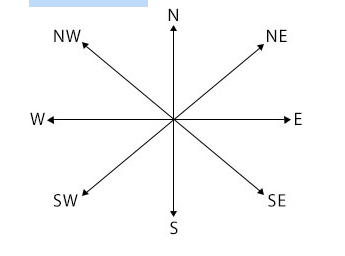
TO GET YOUR COMPLETE LESSON NOTE AT AN AFFORDABLE PRICE, HIT THE WHATSAPP BUTTON BELOW
ACCESS ALL QUESTIONS AND ANSWERS
ACCESS WAEC QUESTIONS AND ANSWERS